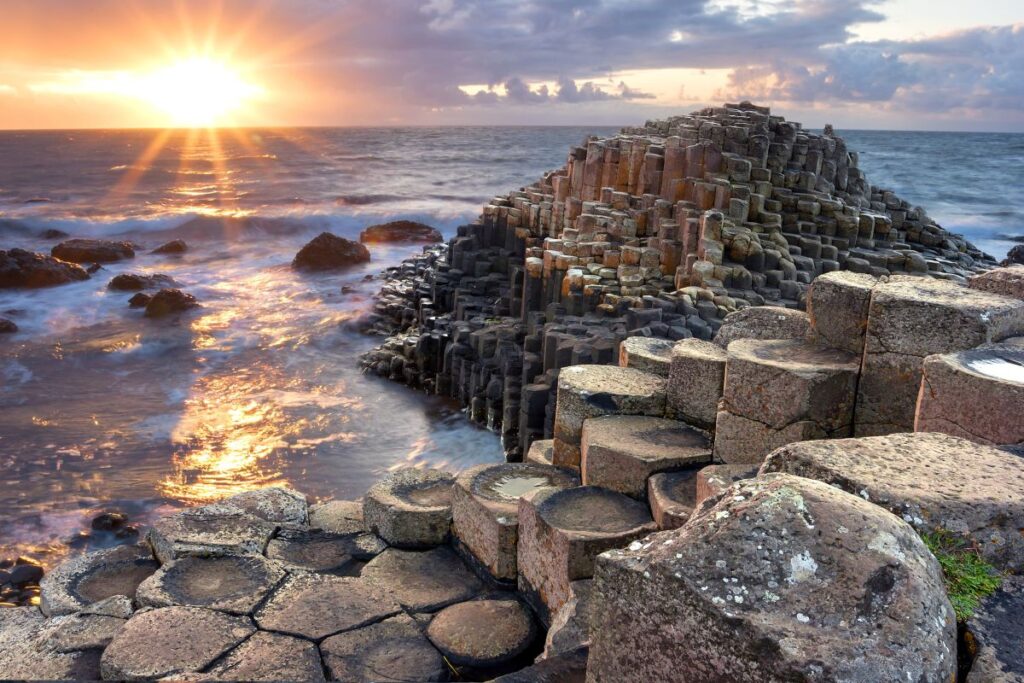Giant’s Causeway . o de los Gigantes (in English: The Giant’s Causeway) is an area that contains about 40,000 columns of basalt from the relatively rapid cooling of lava in a crater or volcanic caldera that occurred about 60 million years ago. It is located on the north east coast of the island of Ireland , about 3 km north of Bushmills in County Antrim, Northern Ireland. It was declared a World Heritage Site in 1986 , and a National Nature Reserve in 1987 . It was discovered in 1693 .

Geographic location
A couple of kilometers from the Northern Irish village of Bushmills, is a spectacular work of nature. Formed by the thermal contraction of volcanic lava more than 60 million years ago, these more than 40,000 columns were created like the ones we can observe today. In this place, we can find hexagonal, heptagonal and even octagonal shapes, which can reach up to 30 meters high, and which end in the sea .
geology
The geological process that gives rise to the formation of basaltic colonnades is relatively simple: the incandescent lava in a volcanic chimney or in a lava flow can get to cool in situ when the volcano or caldera ceases its eruptive activity. This cooling gives rise to the formation of basalt, which is a crystalline rock, although with extremely small crystals due to the fact that its cooling was very rapid and with a much weaker pressure than that supported by igneous rocks that give rise to the formation of granite at greater depths: in fact, basalt forms on the surface of the lava in the crater or caldera and progresses deeper. As the basalt forms, its volume decreases and generally hexagonal prisms are formed, the separation of which compensates for the decrease in volume (columnar disjunction).Later, erosion acts first on the surrounding rocks because the basalt is much more resistant, exposing these columns. The Irish legend of its creation
Legend
The legend of the causeway is geologically corroborated by the fact that there are similar basalt formations, created by the same volcanic eruption, on the island of Staffa in Scotland , more precisely in the cave of Fingal.
The story goes that there were two giants, one from Ireland (Finn) and the other from Scotland (Bennandoner), who got along very badly and continually threw rocks at each other. From throwing rocks so much a field of stones was formed on the sea. The Scottish giant decided to cross the rocky path and defeat his adversary, as he was stronger than the other. The Irish giant’s wife saw the Scottish giant coming, so she decided to dress her husband as a baby. When the Scotsman arrived and saw that the baby was so big, he thought that his father would be triple the size, so he fled, stomping on the rocks, which sank into the sea so that the other giant could not reach Scotland .
Other similar
Although the basaltic columns of the Giant’s Causeway in Northern Ireland are impressive, they are not unique in the world. Basalt columns are a fairly common volcanic feature and can be found to varying degrees, depending on how fast the basalt is cooling. Some of these prominent sites where there are similar sites with basalt columns are the Devils Postpile National Monument in California , the Devils Tower National Monument in Wyoming , the basaltic base of Castellfollit de la Roca in Catalonia , the formation of “organ pipes” in Mont Cargill in New Zealand, the Rocha dos Bordoes in Flores of the Azores Island, in Phu Yen of Vietnam, on the Cicopi island of Sicily, in Garni of Armenia, or in Kunashir, the southernmost island of the Kuril Islands in Russia .
